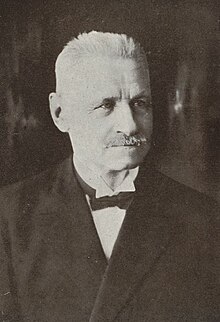Józef Paczoski
Józef Paczoski | |
|---|---|
 Paczoski in 1931. | |
| Born | Józef Konrad Paczoski 8 December 1864 Byalohorodka, Congress Poland (present-day Ukraine) |
| Died | 14 February 1942 (aged 77) |
| Nationality | Polish |
| Alma mater | Jagiellonian University |
| Known for | phytosociology |
| Scientific career | |
| Fields | Botany |
| Institutions | University of Poznań |
Józef Konrad Paczoski (/ˈjʊzɛf pəˈtʃɒski/; 8 December 1864 – 14 February 1942) was a Polish botanist, Professor at the Poznań University and a corresponding member of the Polish Academy of Learning. He coined the term "phytosociology"[1] and was one of the founders of this branch of botany.[2] He is also known for his research on the flora of the Białowieża Forest.[3]
Life and career[edit]
This section needs expansion. You can help by adding to it. (June 2020) |
Paczoski was born on 8 December 1864 in Byalohorodka near Iziaslav, Ukraine in Volhynia. From 1877 he studied botany at faculty of Biological Science at Jagiellonian University and Kiev University under the guidance of Ivan Ivanovich Schmalhausen.[4]

He was an early pioneer of the science of phytosociology, the study of natural plant communities.[2] In 1896 he coined the term "phytosociology".[1] In 1923 he became a scientific manager of the forest reserves in the Białowieża Forest. He did much of his research on the vegetation of the Białowieża National Park.[5] From 1925 to 1931 he was Professor of Plant Systematics and Sociology at Poznań University,[6] where he established the first Institute of Plant Sociology in the world.[citation needed]
He was a member of the Polish Academy of Learning (Polska Akademia Umiejętności), the predecessor of the Polish Academy of Sciences.[7]
Death[edit]
He died on 14 February 1942 in Sierosław near Poznań, Poland of a heart attack, when he heard that his grandson had been beaten up by the Gestapo as Poland was occupied at that time by Nazi Germany.[2]
Plant species named after Jozef Paczoski[edit]
- Allium paczoskianum
- Centaurea paczoskyi
- Hieracium paczoskianum
- Jurinea paczoskiana
- Pyrethrum paczoskii
- Tanacetum paczoskii
- Carex paczoskii
- Lamium paczoskianum
- Chamaecytisus paczoskii (Krecz.)
- Cytisus paczoskii
- Onobrychis paczoskiana
- Gagea paczoskii (Zapal.)
- Corydalis paczoskii
- Papaver paczoskii
- Pistolochia paczoskii
- Veronica paczoskiana
Publications[edit]
- Paczoski J. 1927. Ranunculaceae. In: Szafer W (ed.) Flora polska : Rośliny naczyniowe Polski i ziem ościennych (Polish: Flora of Poland: Vascular plants of Poland and adjacent territories). Vol. III. Kraków: Polska Akademja Umiejętności
- Paczoski J. 1928. La végétation de la Foret de Białowieża (French: The Vegetation of Białowieża Forest). Varsovie.
- Paczoski J. 1928. Biologiczna struktura lasu (Polish : The Biological Structure of Forest). Sylwan 3: 193 - 221.
- Paczoski J. 1929. Die Wälder Bosniens (German: The Forests of Bosnia). Lwów: Polskie Towarzystwo Leśne.
- Paczoski J. 1930. Lasy Białowieży (Polish: The Forests of Białowieża). Monografje Naukowe 1. Warszawa: Państwowa Rada Ochrony Przyrody.
- Paczoski J. 1933. Podstawowe zagadnienia geografji roślin (Polish: Basic concepts in plant geography). Biblioteka Botaniczna. Vol. III. Poznań: Wydawnictwo Polskiego Towarzystwa Botanicznego.
- Paczoski J. 1935. Piętrowość lasu (Polish: Layers of forest vegetation). Biblioteka Botaniczna. Vol. IV. Poznań: Wydawnictwo Polskiego Towarzystwa Botanicznego.
See also[edit]
References[edit]
- ^ a b Rabotnov TA. 1970-1979. Phytocoenology. In: The Great Soviet Encyclopedia, 3rd ed.
- ^ a b c Maycock PF. 1967 Ecology 48:1031-1034 "Jozef Paczoski: founder of the science of phytosociology".
- ^ Władysław Polcyn. "90-lecie walki Profesora Józefa Paczoskiego o niepodległą przyszłość Puszczy Białowieskiej". dzikiezycie.pl (in Polish). Retrieved 2 May 2023.
- ^ Kozlowski, S. (2009). "Profesor Józef Paczoski–twórca fitosocjologi". Łąkarstwo w Polsce. 12. Retrieved 2 May 2023.
- ^ "Short description of the Białowieża National Park on the CarboForest Conference site". Carboforest.eu. Archived from the original on 2011-07-20. Retrieved 2011-08-06.
- ^ O. Bezlutska (29 January 2017). "Scientific-pedagogical and educational activities J. K. Pachoski" (PDF). seanewdim.com. Retrieved 2 May 2023.
- ^ "Trees of Bialowieza National Park. Dedication". Drzewa.puszcza-bialowieska.eu. Retrieved 2011-08-06.
